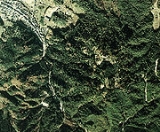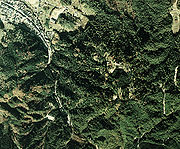
Iwamura Castle
Encyclopedia

Mino Province
, one of the old provinces of Japan, encompassed part of modern-day Gifu Prefecture. It was sometimes called . Mino Province bordered Echizen, Hida, Ise, Mikawa, Ōmi, Owari, and Shinano Provinces....
in Japan
Japan
Japan is an island nation in East Asia. Located in the Pacific Ocean, it lies to the east of the Sea of Japan, China, North Korea, South Korea and Russia, stretching from the Sea of Okhotsk in the north to the East China Sea and Taiwan in the south...
. Its ruins can be found in the modern-day town of Iwamura
Iwamura, Gifu
was a town located in the former Ena District, Gifu, Japan.On October 25, 2004 Iwamura, along with the towns of Akechi, Kamiyahagi and Yamaoka, and the village of Kushihara, all from Ena District, merged with the old city of Ena to form the new city of Ena, and no longer exists as an independent...
in Ena District
Ena District, Gifu
was a district located in Gifu, Japan.On October 25, 2004 five towns and villages in the district merged with the city of Ena. On February 13, 2005 the remaining six towns and villages in the district merged into the city of Nakatsugawa at which point the district ceased to exist.As of 2003, the...
, Gifu Prefecture
Gifu Prefecture
is a prefecture located in the Chūbu region of central Japan. Its capital is the city of Gifu.Located in the center of Japan, it has long played an important part as the crossroads of Japan, connecting the east to the west through such routes as the Nakasendō...
.
History
From the 13th to 16th centuries, it was in the fief of the Tōyama clan (遠山氏 Tōyama-shi). In 1572, after the Siege of IwamuraSiege of Iwamura
The 1572 siege of Iwamura was concurrent with Takeda Shingen's push into Tōtōmi Province and the famous Battle of Mikatagahara. Akiyama Nobutomo, one of Shingen's "Twenty-Four Generals," set his eye on the great yamashiro of Iwamura when Tōyama Kagetō, the commander of the castle's garrison, fell...
, Takeda Shingen
Takeda Shingen
, of Kai Province, was a preeminent daimyo in feudal Japan with exceptional military prestige in the late stage of the Sengoku period.-Name:Shingen was called "Tarō" or "Katsuchiyo" during his childhood...
took the castle and entrusted it to Akiyama Nobutomo
Akiyama Nobutomo
was a samurai during the Age of Warring States in Japan. He was a retainer in the service of the Takeda family who served as one of the Twenty-Four Generals of Takeda Shingen. Nobutomo also served under Shingen's son, Takeda Katsuyori.-Early career:...
. In 1575, Oda Nobunaga
Oda Nobunaga
was the initiator of the unification of Japan under the shogunate in the late 16th century, which ruled Japan until the Meiji Restoration in 1868. He was also a major daimyo during the Sengoku period of Japanese history. His opus was continued, completed and finalized by his successors Toyotomi...
attacked and took the castle and placed it under the command of Toyotomi Hideyoshi
Toyotomi Hideyoshi
was a daimyo warrior, general and politician of the Sengoku period. He unified the political factions of Japan. He succeeded his former liege lord, Oda Nobunaga, and brought an end to the Sengoku period. The period of his rule is often called the Momoyama period, named after Hideyoshi's castle...
. Hideyoshi in turn transferred power of Iwamura Castle to Tamaru Tomotada. After the Battle of Sekigahara
Battle of Sekigahara
The , popularly known as the , was a decisive battle on October 21, 1600 which cleared the path to the Shogunate for Tokugawa Ieyasu...
, it was occupied under Tokugawa
Tokugawa clan
The was a powerful daimyo family of Japan. They nominally descended from Emperor Seiwa and were a branch of the Minamoto clan by the Nitta clan. However, the early history of this clan remains a mystery.-History:...
rule by the Ogyu Daimyo from 1601 to 1638, by the Niwa clan
Niwa clan
The ' was a Japanese samurai clan which rose to prominence in the Sengoku period. Its members claimed descent from the medieval Kodama family. Famous clan members included Oda Nobunaga's senior retainer Niwa Nagahide, as well as Nagahide's 19th century descendants Niwa Nagatomi, Niwa Nagakuni, and...
from 1638 to 1702, and finally by the Ishikawa clan
Ishikawa clan
The ' was a Japanese family which claimed descent from Minamoto no Yoshiie. They took their name from the Ishikawa district of Kawachi Province. In the Sengoku Period, the family had two major branches; one of them, which had settled in Mikawa Province in the 15th century, was a family of retainers...
from 1702 until the end of the Tokugawa period in 1868.

